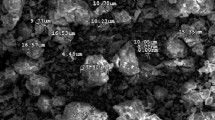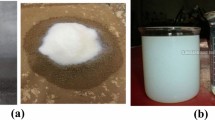Abstract
Stabilization of soils with additives is a widely used improvement method. With the mass production of nanomaterials in various fields, and their application in geotechnical engineering discipline, it is essential to investigate the characteristics of soils mixed with nanoparticles and examine their effect on the various chemical, physical, and mechanical properties of soils. This research is an attempt to examine the performance of clayey soils treated with nano-silica (NS) as an additive. To achieve this goal, the Atterberg limits, standard compaction, permeability, and unconsolidated undrained (UU) tests were performed on a fine-grained soil mixed with 1, 2, 3, and 4 wt% of NS. Scanning Electron Microscopy (SEM) was also used to observe the texture variation of NS-treated and non-treated samples. The X-Ray Diffraction Fluorescence (XRF) test was conducted on the soil specimen to find out the percentage of existing elements. The results showed that adding NS to the soil decreases the plasticity index, increases the maximum dry density, increases the optimum moisture content, and reduces the permeability coefficient. It was found that the permeability coefficient of the samples which were treated with NS, decreased, compared to that of the natural sample. Furthermore, an additional 60–68% maximum strength was achieved by conducting triaxial UU tests on the sample treated with 2% NS under a confining pressure. Additionally, the cohesion and internal friction angle of NS-treated sample increased in comparison to the sample not treated with NS. Furthermore, the SEM images of NS-stabilized samples represent the physical and chemical bonds between soil particles and NS.













Similar content being viewed by others
References
Al-Bared, M.A.M.; Harahap, I.S.H.; Marto, A.; Alavi Nezhad Khalil Abad, S.V.; Mustaffa, Z.; Ali, M.O.A.: Mechanical behaviour of waste powdered tiles and Portland cement treated soft clay. Geomech. Eng. 19, 37–47 (2019)
Taha, M.R.; Taha, O.M.: Crack control of landfill liner and cap materials using nano-alumina powder. Coup. Phenom. Environ. Geotech. 215, 459–463 (2013)
Niroumand, H.; Zain, M.F.M.; Alhosseini, S.: The influence of nano-clays on compressive strength of earth bricks as sustainable materials. Procedia. Soc. Behav. Sci. 89, 862–865 (2013)
Luo, H.L.; Hsiao, D.H.; Lin, D.F.; Lin, C.K.: Cohesive soil stabilized using sewage sludge ash/cement and nano aluminum oxide. Int. J. Trans. Sci. Technol. 1, 83–99 (2012)
Paul, K.T.; Satpathy, S.K.; Manna, I.; Chakraborty, K.K.; Nando, G.B.: Preparation and characterization of nano structured materials from fly ash: a waste from thermal power station, by high energy ball milling. Nanoscale Res. Lett. 2, 397–404 (2007)
Yarbasi, N.; Kalkan, E.; Akbulut, S.: Modification of freezing–thawing properties of granular soils with waste additives. Cold Reg. Sci. Technol. 48, 45–54 (2007)
Taha, M.; Alsharef, J.; Khan, T.; Aziz, M.; Gaber, M.: Compressive and tensile strength enhancement of soft soils using nanocarbons. Geomech. Eng. 16, 559–567 (2018)
Majdi, M.; Uromiei, A.; Nikudel, M.: Natural nanoparticles effect on geotechnical properties of clayey soil. J. Eng. Appl. Sci. 11, 361–368 (2016)
Ghazi, H.; Baziar, M.H.; Mirkazemi, S.M.: The effects of nano-material additives on the basic properties of soil. In: Proceedings of the14th Asian Regional Conference of Geotechnic, Hong-Kong, China (2011)
Firoozi, A.; Taha, M.; Firoozi, A.: The influence of freeze-thaw cycles on unconfined compressive of clay soils treated with lime. J. Teknologi 76, 107–113 (2015)
Changizi, F.; Haddad, A.: Strength properties of soft clay treated with mixture of nano-SiO2 and recycled polyester fiber. J. Rock Mech. Geotech. Eng. 7, 367–378 (2015)
Majeed, Z.H.; Taha, M.R.: Effect of nanomaterial treatment on geotechnical properties of a Penang soft soil. In: Proceedings of the 1st International Conference on Engineering and Built Environment, Bejing, China (2012)
Ahmadi, H.; Shafiee, O.: Experimental comparative study on the performance of nano-SiO2 and microsilica in stabilization of clay. Eur. Phys. J. Plus 134, 459 (2019)
Kannan, G.; Sujatha, E.R.: A review on the choice of nano-silica as soil stabilizer. SILICON (2021). https://doi.org/10.1007/s12633-021-01455-z
ASTM: D2487–11: Standard Practice for Classification of Soils for Engineering Purposes (Unified Soil Classification System). ASTM International, West Conshohocken, PA, USA, pp. D2487–11 (2011). http://www.astm.org/cgi.bin/resolver.cgi
ASTM: D422–63: Standard Test Method for Particle-Size Analysis of Soils. ASTM International, West Conshohocken, PA, USA, pp. D422–63e2 (2007). http://www.astm.org/cgi-bin/resolver.cgi
Kalhor, A.; Ghazavi, M.; Roustaei, M.; Mirhosseini, S.M.: Influence of nano-SiO2 on geotechnical properties of fine soils subjected to freeze-thaw cycles. Cold Reg. Sci. Technol. 161, 129–136 (2019)
Al-Murshedi, A.D.; Karkush, M.O.; Karim, H.H.: Collapsibility and shear strength of gypseous soil improved by nano silica fume (NSF). Key Eng. Mater. 857, 292–301 (2020)
ASTM: D4318–10: Standard Test Methods for Liquid Limit, Plastic Limit, and Plasticity Index of Soils. ASTM International, West Conshohocken, PA, USA, pp. D4318–10e1 (2010). http://www.astm.org/cgi-bin/resolver.cgi
ASTM: D698–12: Standard Test Methods for Laboratory Compaction Characteristics of Soil Using Standard Effort (12 400 ft-lbf/ft3 (600 kN-m/m3)). ASTM International, West Conshohocken, PA, USA, pp. D698–12e2 (2012). http://www.astm.org/cgibin/resolver.cgi
Kalkan, E.; Akbulut, S.: The positive effect of silica fume on the permeability, swelling pressure and compressive strength of natural clay liners. Eng. Geol. 73, 145–156 (2004)
Kalkan, E.: Effects of silica fume on the geotechnical of fine-grained soils exposed to freeze and thaw. Cold Reg. Sci. Technol. 58, 130–135 (2009)
ASTM: D2434: Standard Test Method for Permeability of Granular Soils (Constant Head), ASTM International, West Conshohocken, PA, USA, pp. D2434 (2006). http://www.astm.org/cgi.bin/resolver.cgi
ASTM: D2850: Standard Test Method for Unconsolidated-Undrained Triaxial Compression Test on Cohesive Soils, ASTM International, West Conshohocken, PA, USA, pp. D2850 (2007). http://www.astm.org/cgi.bin/resolver.cgi
Karkush, M.O.; Ali, H.A.; Ahmed, B.A.: Improvement of unconfined compressive strength of soft clay by grouting gel and silica fume. In: Proceedings of China-Europe Conference on Geotechnical Engineering, pp. 546–550 (2018)
Author information
Authors and Affiliations
Corresponding author
Rights and permissions
About this article
Cite this article
Kalhor, A., Ghazavi, M. & Roustaei, M. Impacts of Nano-silica on Physical Properties and Shear Strength of Clayey Soil. Arab J Sci Eng 47, 5271–5279 (2022). https://doi.org/10.1007/s13369-021-06453-2
Received:
Accepted:
Published:
Issue Date:
DOI: https://doi.org/10.1007/s13369-021-06453-2




